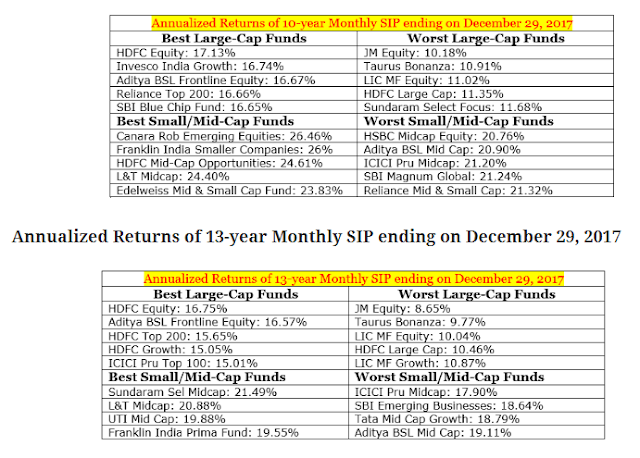Bears disrupted the extended reign of bulls on Dalal Street, dragging down benchmark indices over 5.5 percent in two consecutive weeks, and in effect, aligning market valuations with earnings and economic growth.
A sell-off, warranted for a long time, was eventually caused by two events – first, the Budget 2018 where government imposed 10 percent long term capital gains tax on equity and 10 percent dividend distribution tax on equity oriented MF, and raised fiscal deficit target; and second global developments where expectations increased for a faster hike in US interest rates (more than three) hinting early inflationary pressures on tight labour market with higher wages. RBI in its policy also cited inflation concerns while keeping repo rate unchanged.
Losses over the last two weeks wiped out the year-to-date gains in 2018 with investors losing Rs 7.79 lakh crore worth of wealth in just the two weeks. The 50-share NSE Nifty had rallied 29 percent in 2017, taking total gains before correction to over 35 percent (i.e. till January 25, 2018) on hopes of earnings and economic recovery.
There was, however, some sigh of relief only in broader markets in the passing week as mid and smallcaps recovered on bargain hunting, with the Nifty Midcap index rising 0.6 percent and BSE Smallcap gaining 1.8 percent (on earnings recovery in Q3FY18) after losing 8 percent in previous week.
Here are things that will keep investors busy next week:
Earnings
We are at the fag end of the earnings season and majority of largecaps as well as midcaps have already declared earnings. Earnings announced, so far, are stable to better-than-expected.
"The current earnings season is providing strong signs of revival in corporate earnings underlining the long term growth prospects, which is providing relief for investors," Vinod Nair, Head Of Research at Geojit Financial Services said.
More than 2,000 companies will announce December quarter numbers in the coming week, which include some PSU banks, engineering & construction, real estate, sugar firms etc.
Monday (566 companies): GAIL, Bank of India, Britannia Industries, Motherson Sumi, Indian Bank, Power Finance Corporation, NHPC, Sadbhav Engineering, Corporation Bank, Mangalam Cement;
Tuesday (504) : DLF, Shipping Corporation, MMTC, JK Tyre, IL&FS Engineering, Abab Offshore, CG Power, Snowman Logistics, Shalimar Paints, Max India, PTC India Financial, NMDC, NBCC, Punjab & Sind Bank, Indian Overseas Bank, Godfrey Phillips India, GMR Infrastructure, Fortis Healthcare, Chambal Fertilizers, Bajaj Hindusthan, Dilip Buildcon, CRISIL;
Wednesday (1,110): Sun Pharma, Tata Power, Grasim Industries, Jet Airways, Dena Bank, Allahabad Bank, DB Realty, Zicom Security, HDIL, Godrej Industries, Vivimed Labs, Satin Creditcare, Sakthi Sugars, Titagarh Wagons, Steel Strips Wheels, Shriram EPC, Speciality Restaurants, Pratibha Industries, PNC Infratech, NLC India, NCC, Rolta India, Repco Home Finance, Shree Renuka Sugars, Religare Enterprises, MT Educare, Rana Sugars, Punj Lloyd, Prism Cement, Patel Engineering, Infibeam Incorporation, Jindal Stainless, IVRCL, JBM Auto, Globus Spirits, Gitanjali Gems, Gammon Infrastructure, Endurance Technologies, GVK Power, GTPL Hathway, 8K Miles, Ballarpur Industries, Bharat Road Network, Bhushan Steel, Ahluwalia Contracts;
Thursday (7): Vesuvius India;
Friday: Varun Beverages.
Sun Pharma
Sun Pharma, which will announce its October-December quarter earnings on Wednesday, is expected to report weak numbers especially due to continued US pricing pressure but domestic numbers could be good.
"Companies like Sun Pharma, while having strong domestic presences will struggle to show growth in Q3FY18 due to the absence of significant launches in the US market. Current regulatory issues for Sun Pharma (warning letter for Halol plant) have stifled launches in the US market in the recent past and we expect this to reflect in the current quarter’s US numbers," HDFC Securities said.
It expects company's topline is likely to decline around 11 percent YoY, owing to the high base (gGleevec) and increasing pressure on Taro’s business. The launch of gCoreg CR (first generic) will mitigate some of the decline, it feels.
Prabhudas Lilladher expects 16.6 percent fall in topline, 47 percent in operating income and 40 percent in profitability while HDFC sees EBITDA margin to continue to show some sequential improvement on the back of QoQ growth in the US business and resulting operating leverage.
Key things to watch out for would be FY19 generic launch guidance, updates on Halol facility re-inspection and specialty pipeline progress.
Taro Pharma, the subsidiary which announced earnings last week, reported 30 percent decline in topline due to price erosion in the US, 87 percent fall in bottomline on one time charge of USD 38 million due to tax changes in US and 1,880 basis points contraction in operating profit margin.
PSU Banks
Country's largest lender State Bank of India, on Friday, reported quarterly loss (Rs 2,416 crore) for the first time in almost 17 years, with higher slippages and weak asset quality performance. Even loan and deposit growth was muted in Q3FY18.
Bank of Baroda also reported a 56 percent fall YoY in profit on higher provisions and marginally higher asset quality.
Stocks may react to bad numbers on Monday, but analysts feel there could be some improvement from Q4 and FY19 onwards in banks earnings. Infact, FY19 could be far better than FY18, they said.
"Worst is behind us and heading into FY19, lot of resolutions in Q1FY18 would clean up the path for corporate banks to move ahead strongly. Next 3-6 months could be challenging but after that there would be greener pasture," Krishna Kumar of Sundaram MF said.
Bank of India, Indian Bank, Corporation Bank, Indian Overseas Bank, Dena Bank and Allahabad Bank will announce quarterly earnings in the coming week.
Macro Data
Industrial and manufacturing production data for December month, and CPI inflation for January will be released on Monday while WPI inflation for January will be announced on Wednesday.
IIP growth in November jumped to 17-month high of 8.4 percent from 2 percent in October while Consumer Price Index inflation increased to 5.21 percent in December from 4.88 percent in previous month.
Balance of trade data for January will be declared on Thursday. Foreign exchange reserves for the week ended February 9, and deposit & bank loan growth for week ended February 2 will be released on Friday.
India’s forex reserves surged by USD 4.1 billion to a new high of USD 421 billion for week ended February 2.
Technical Outlook
Technical analysts feel the underlying trend of the market is still weak and breaking of 10,000 can be possible in short term.
"The trend of Nifty as per weekly and monthly is down. The present weakness is expected to continue in the coming weeks or months. Although Nifty placed at the immediate support of around 10,400 levels, the support could eventually be broken on the downside. One may expect Nifty to slip below the recent low of 10,276 levels," Nagaraj Shetti, Technical Research Analyst at HDFC Securities said.
Any attempt of upside bounce is going to be a sell on rise opportunity for next week and the downside targets to be watched is around 10,000-mark for the next couple of weeks, he added.
According to Ashwani Gujral, ashwanigujral.com, the market is expected to remain choppy in the coming week and 10,300-10,600 could be trading band for the Nifty.
F&O
F&O data also indicated that there could be further weakness in the market going ahead.
"The Call writers in the Nifty have been rolling their positions lower, which suggests towards increasing pressure on the index as we are approaching settlement. Profit booking is seen in 10900 Call writing positions and now these are getting formed at 10500-10600 Call strikes," ICICIdirect said.
It further said, "The pressure due to long liquidation is quite evident in so far outperforming Nifty heavyweights. This may keep the index under pressure for some time. If the Nifty is unable to hold above 10,600, it can slip towards 10,250 again towards settlement."
On Friday, Call writing was seen at the strike price of 10,400, which saw the addition of 7.99 lakh contracts along with 10,500, which added 5.07 lakh contracts, along with 10,600, which saw the addition of 4.22 lakh contracts.
Maximum Put writing was seen at the strike price of 10,100, which saw the addition of 6.94 lakh contracts, followed by 10,200, which added 5.62 lakh contracts and 10,400, which added 3.63 lakh contracts.
IPO
Healthcare services provider Aster DM Healthcare will open its IPO for subscription on Monday, with a price band of Rs 180-190 per share.
The company aims to raise up to Rs 980 per share at higher end of price band, of which it already garnered Rs 294 crore from anchor investors on February 9.
The issue, which will close on February 15, consists of a fresh issue of up to Rs 725 crore and an offer for sale of up to 1,34,28,251 equity shares by the promoter, Union Investments Private Limited.
The fresh issue proceeds would be utilised for repayment of debt; purchase of medical equipment; and general corporate purposes
Stocks in Focus
On coming Monday, State Bank of India, ONGC, Mahindra & Mahindra, BPCL, Bank of Baroda, Marico, Tata Steel, Sobha, Nalco, Sun TV Network, Capacit’e Infraprojects, PTC India, Va Tech Wabag, Amara Raja Batteries, MOIL, Syndicate Bank, Oil India, Suzlon Energy, Technofab Engineering, and RCF stocks will react to their earnings.
SIS India will react positively as the company bagged contract for security arrangements at Commonwealth Games.
Global Cues
On Monday, Indian market may react to the Friday's bounce back on Wall Street on but the sustainability of recovery could be difficult going ahead. The Dow Jones ended 330 points higher on last day of the week.
Japan's Q4 GDP; Europe's Q4 GDP and industrial production for December month, and United States' January CPI will be released on Wednesday.
On Thursday, Japan's December core machinery orders & industrial production; and US' January industrial & manufacturing production data will be announced.
MORE WILL UPDATE SOON!!


















